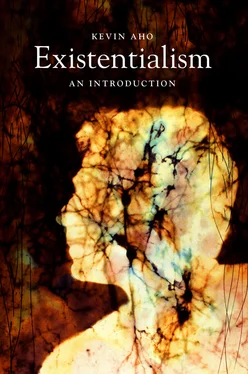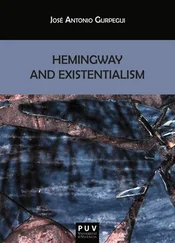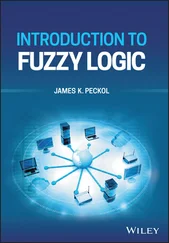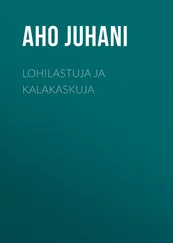Kevin Aho - Existentialism - An Introduction
Здесь есть возможность читать онлайн «Kevin Aho - Existentialism - An Introduction» весь текст электронной книги совершенно бесплатно (целиком полную версию без сокращений). В некоторых случаях можно слушать аудио, скачать через торрент в формате fb2 и присутствует краткое содержание. Год выпуска: 2013, ISBN: 2013, Издательство: Polity, Жанр: Философия, на английском языке. Описание произведения, (предисловие) а так же отзывы посетителей доступны на портале библиотеки ЛибКат.
- Название:Existentialism: An Introduction
- Автор:
- Издательство:Polity
- Жанр:
- Год:2013
- ISBN:978-0745651422
- Рейтинг книги:3 / 5. Голосов: 1
-
Избранное:Добавить в избранное
- Отзывы:
-
Ваша оценка:
- 60
- 1
- 2
- 3
- 4
- 5
Existentialism: An Introduction: краткое содержание, описание и аннотация
Предлагаем к чтению аннотацию, описание, краткое содержание или предисловие (зависит от того, что написал сам автор книги «Existentialism: An Introduction»). Если вы не нашли необходимую информацию о книге — напишите в комментариях, мы постараемся отыскать её.
Existentialism: An Introduction
Existentialism: An Introduction — читать онлайн бесплатно полную книгу (весь текст) целиком
Ниже представлен текст книги, разбитый по страницам. Система сохранения места последней прочитанной страницы, позволяет с удобством читать онлайн бесплатно книгу «Existentialism: An Introduction», без необходимости каждый раз заново искать на чём Вы остановились. Поставьте закладку, и сможете в любой момент перейти на страницу, на которой закончили чтение.
Интервал:
Закладка:
The aesthetic sphere is the one that most of us live in as children, adolescents, and young adults. In this stage, we are caught up in the sensual pleasures and intoxications of the present moment. Using the character of Don Juan as an archetype, Kierkegaard portrays the aesthete as one who is unconcerned with moral obligations; he or she is focused only on the satisfaction of immediate pleasures, whether it is sex, food and drink, travel, or shopping. The life of the aesthete is reduced to the consumption of transitory pleasures and flight from the threat of pain and boredom. Kierkegaard sees the aesthetic life as one that ultimately leads to despair, not merely because temporal pleasures are short-lived and pull us into an empty cycle of searching for the next thrill, but because the aesthete is not yet an ‘individual’ or a ‘self.’ To be a self, for Kierkegaard, requires difficult, life-defining choices that synthesize and bind together the temporal moments of one's life into a coherent and lasting whole. “A human being is a synthesis of the infinite and the finite,” writes Kierkegaard, “of the temporal and the eternal. … Looked at in this way, [the aesthete] is not yet a self” (1989, 43, my emphasis). To the extent that the aesthete is unable to make a unifying commitment, he or she is fundamentally inauthentic, dispersed, and pulled apart by the finite pleasures of the moment and suffers from the despair of “not wanting to be itself, [of] wanting to be rid of itself” (43).
It is possible, however, through a transformative emotional crisis to become aware of the underlying emptiness of the aesthetic life and realize existence is more than a hedonistic masquerade. It is at these times that we begin to grasp the seriousness of our own existence, that life requires difficult commitments, and that these commitments have the power to pull the fragmented and disjointed moments of our lives together and constitute us as selves . In Either/Or , Kierkegaard's character Judge Wilhelm warns the pleasure-seeking aesthete:
One … wishes that some day the circumstances of your life may tighten upon you the screws in its rack and compel you to come out with what really dwells in you. … Life is a masquerade, you explain, and for you this is inexhaustible material for amusement; and so far, no one has succeeded in knowing you. … In fact you are nothing. … Do you not know that there comes a midnight hour when everyone has to throw off his mask? … I have seen men in real life who so long deceived others that at last their true nature could not reveal itself. … Or can you think of anything more frightful than that it might end with your nature being resolved into a multiplicity, that you really might become many, become, like those unhappy demoniacs, a legion and you thus would have lost the inmost and holiest of all in a man, the unifying power of personality? (1946a, 99)
In taking a deliberate and principled stand on one's life, one enters the ethical sphere by renouncing temporal pleasures and committing oneself to eternal moral principles. Here, Kierkegaard is drawing on Kant's ethics that regards the moral agent as duty-bound to a set of universal laws — such as the Ten Commandments or the Golden Rule — that apply to everyone and take priority over one's own selfish interests and inclinations. “The ethical as such is the universal,” writes Kierkegaard, “and as the universal it applies to everyone, which can be put from another point of view by saying that it applies at every moment” (1985, 83). With this commitment, the individual is ‘willing to be oneself’ because he or she has made the difficult ‘either/or’ choice that provides the coherence and unity necessary in being a self. Judge Wilhelm illustrates this distinction by articulating the moral duties of marriage. The ethical individual renounces the fleeting pleasures of sensual love or lust and instead chooses to be a self by making a life-defining commitment to an eternal principle, to the universal ideal of marriage. Thus, “the true eternity in love, as in true morality, delivers it, first of all from the sensual. But in order to produce this true eternity, a determination of the will [a choice] is called for” (Kierkegaard 1946a, 83).
The ethical sphere remains problematic, however, precisely because it sets the universal above the subjective needs of the individual. In stoically committing oneself to universal principles and renouncing one's own particular needs, the ethical individual is detached from the concrete realities of existence itself. The husband, for instance, who devotes himself to the ideal of marriage runs the risk of being cut off from the subjective upheavals of actually being in love . Again, for Kierkegaard, the highest form of truth is not objective and universal but subjective and particular . This means that objective moral principles are not universally binding. There may be times in one's life when one must suspend his or her obligations to the ethical and be guided by higher-order values that arise from one's own subjective passions. It is at this stage that one enters the religious sphere, the sphere of faith.
For Kierkegaard, being true to oneself requires passing into the religious sphere and ‘becoming a Christian,’ but this has nothing to do with being a member of a church and blindly accepting ‘Articles of Faith.’ Such a view creates the kind of self-satisfied conformism that existentialists reject. On Kierkegaard's view, becoming a Christian requires a passionate inward commitment precisely because of the absurdity and irrationality of its doctrines. It is not difficult to accept a set of plausible moral principles, but it is terrifying to be a Christian because of its implausibility. Indeed, it is the absurdity that makes the religious life possible. It requires the highest form of individuation, a ‘leap’ into a paradox that cannot be rationally justified and a willingness to suspend one's obligations to the ethical sphere.
In Fear and Trembling , Kierkegaard uses the biblical figure of Abraham to illustrate the experience of individuation that occurs as one moves from the ethical to the religious sphere. The ethical reveals to Abraham a universal commandment, that under any and all circumstances a father must protect and love his child. But he is told by God to break this moral code and kill his son. He is caught in a horrifying conflict where he must either disobey the word of God or violate a universal moral imperative. In his willingness to sacrifice his son, Abraham becomes a ‘knight of faith.’ He breaks his commitment to ethical principles and chooses a higher truth: the truth embodied in the solitary individual who stands in anguished freedom before himself and an absurd and incomprehensible God. With a religious conscience, Abraham makes the ‘leap of faith,’ accepting the maddening paradox that his own individual needs are of infinite importance and, therefore, higher than the universal and ethical. “Faith is just this paradox,” writes Kierkegaard, “that the single individual is higher than the universal, though in such a way, be it noted, that the movement is repeated, that is, that, having been in the universal, the single individual now sets himself apart as the particular above the universal” (1985, 84). As a paradox, Abraham's choice is incomprehensible to others. In making the leap he has “discover[ed] something that thought cannot think” (1936, 29). There are no reasons to explain his actions. By all appearances, “he is insane and cannot make himself understood to anyone” (1985, 103). This is because one's own subjective truth cannot be expressed objectively; it can only be felt with the intensity and passion of the individual who makes the choice.
The philosopher Bernard Williams offers a secularized version of Kierkegaard's ‘suspension of the ethical’ with an account based loosely on the life of the French painter Paul Gauguin. On Williams's reading, Gauguin, in pursuing the life-defining commitment to be an artist, abandons his wife and children to a desperate financial situation and moves to Tahiti, where he believes the tropical setting will allow him to develop more fully as a painter. Although he feels a strong sense of moral duty to his family, he is drawn by deeper values that conflict with universal principles and rational justifications. Williams describes the tension between the values of morality and the values of the individual, writing that “while we are sometimes guided by the notion that it would be the best of worlds in which morality were universally respected and all men were of a disposition to affirm it, we have, in fact, deep and persistent reasons that that is not the world we have” (1981, 23). Like Kierkegaard, Williams sees traditional conceptions of morality as generally following the Kantian formula that moral values are rational and universal. Yet in Gauguin's case we see that there are values — grounded in the idiosyncratic passions of the individual — that fall outside the purview of reason and morality, and this means that morality cannot be the sole source of value. Williams's underlying point is not to claim that moral considerations are unimportant, but that “each person has a life to lead” (1985, 186), and this means that, in being true to myself, I may have to make the painful choice of breaking these binding commitments because they do not adequately reflect the values that matter to me as an individual.
Читать дальшеИнтервал:
Закладка:
Похожие книги на «Existentialism: An Introduction»
Представляем Вашему вниманию похожие книги на «Existentialism: An Introduction» списком для выбора. Мы отобрали схожую по названию и смыслу литературу в надежде предоставить читателям больше вариантов отыскать новые, интересные, ещё непрочитанные произведения.
Обсуждение, отзывы о книге «Existentialism: An Introduction» и просто собственные мнения читателей. Оставьте ваши комментарии, напишите, что Вы думаете о произведении, его смысле или главных героях. Укажите что конкретно понравилось, а что нет, и почему Вы так считаете.












